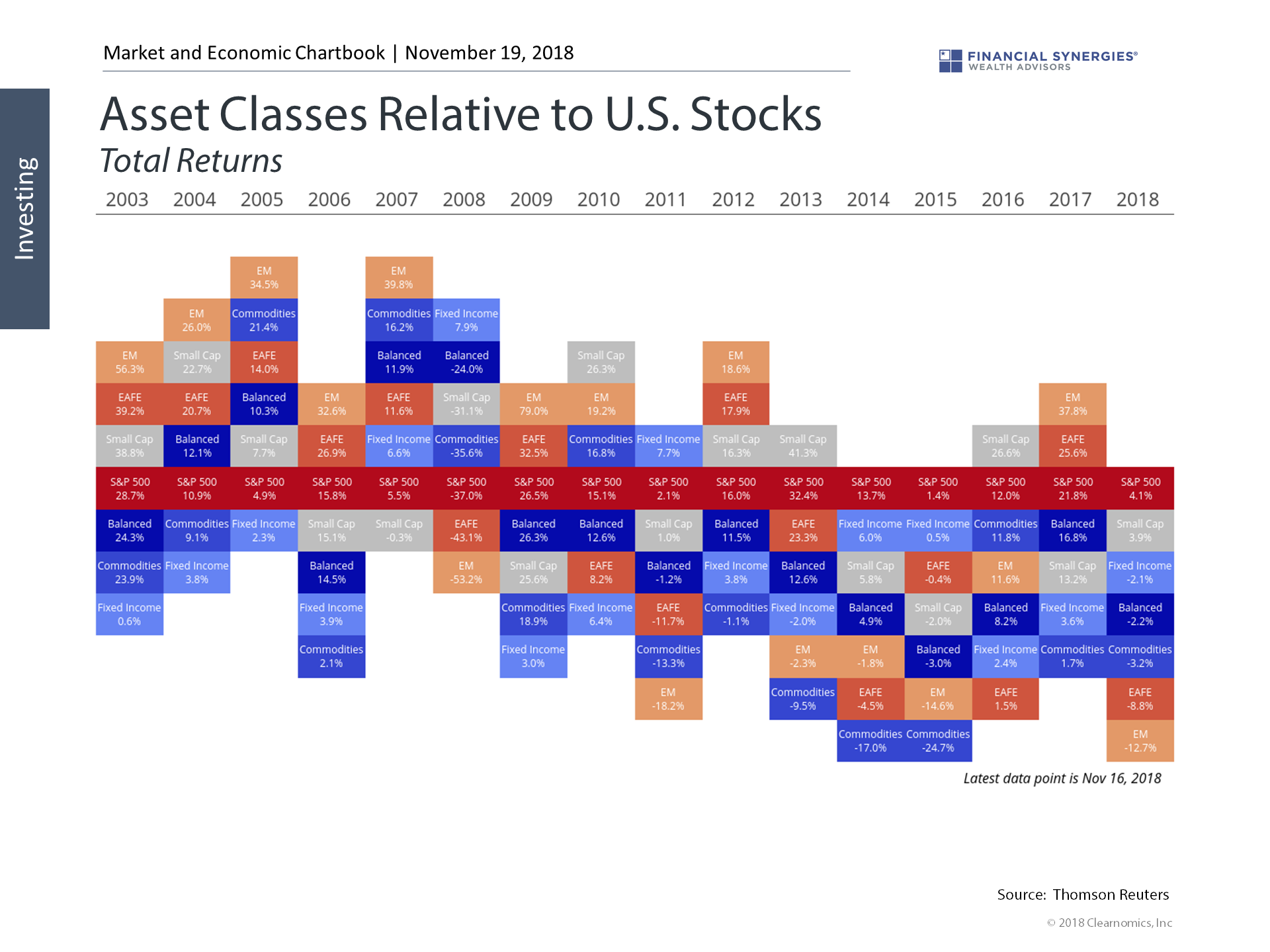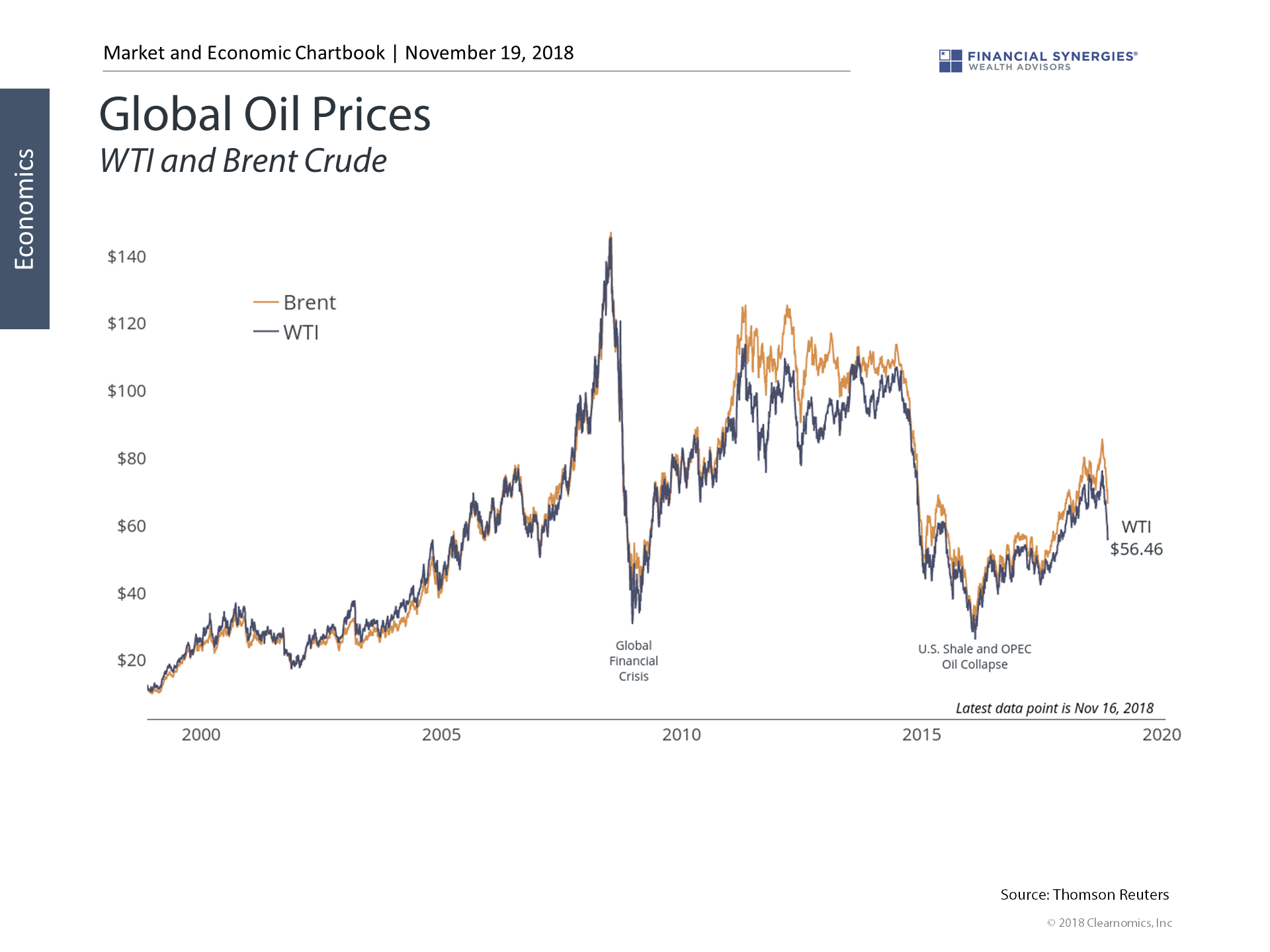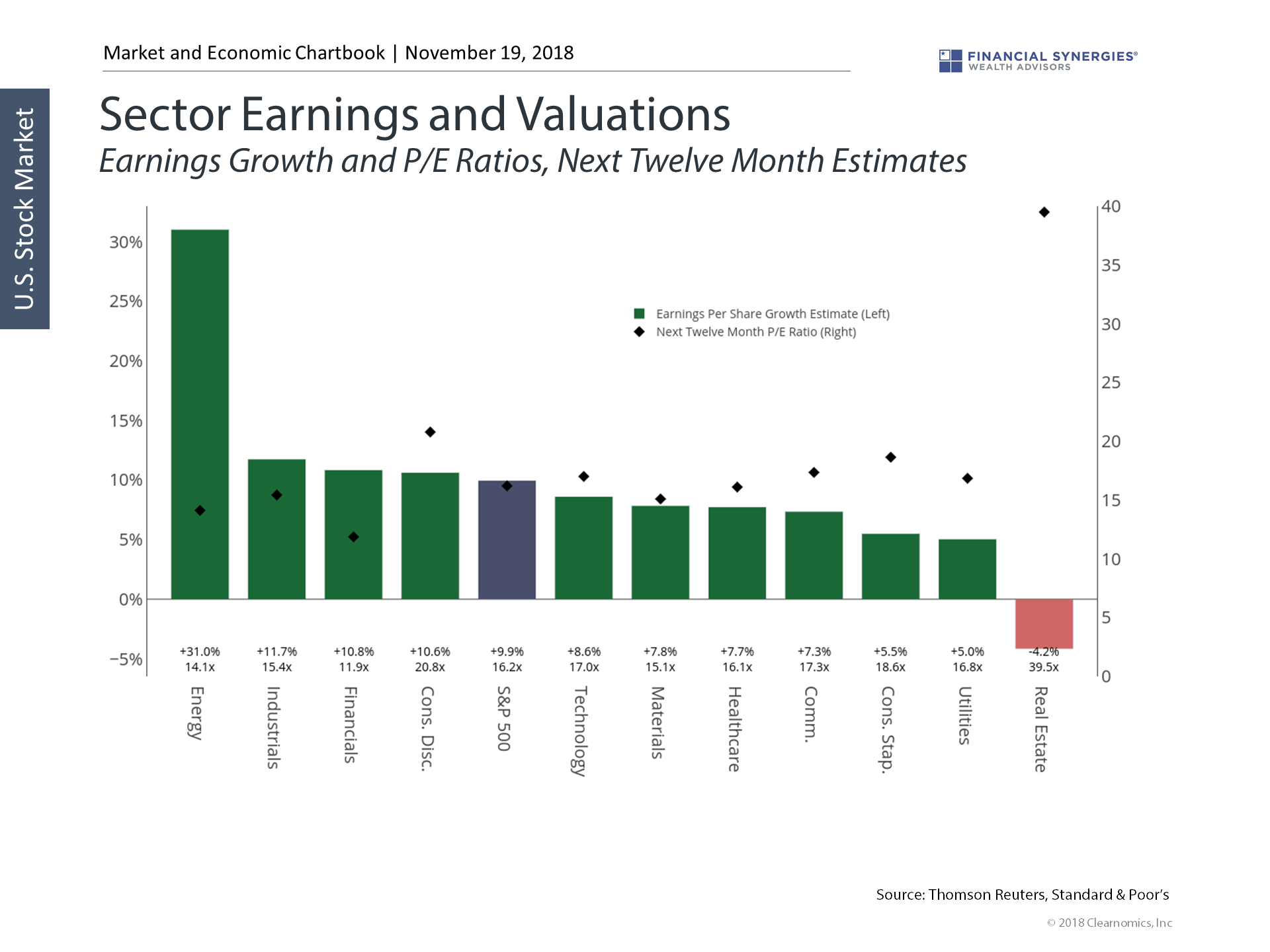Although 2018 has not been fun for investors, this Thanksgiving I’m thankful for the decade-long bull market and economic expansion. Investors who stuck to their financial plans and stayed invested are closer to achieving their long-term goals. But just as enjoying a Thanksgiving feast without overindulging requires discipline, it’s important to keep a long-term perspective and maintain a balanced portfolio as volatility rises.
It’s no secret that there are a number of concerns on investors’ minds of late. Oil prices are in bear market territory, as are some individual stocks – most noticeably in tech. The housing market is experiencing a softening of demand as interest rates rise. And the issues of trade disputes, Brexit, and the pace of corporate earnings growth still linger.
Despite these concerns, the economy and markets are healthy. The collapse in oil isn’t quite the same as when prices fell four years ago. And while tech stocks are an important part of the market, it’s unreasonable to expect that they can only go up. We’re probably in the later stages of the economic cycle, but it’s hard to know whether we’ll finish the meal with a humble dinner mint or with several five-star dessert courses.
Just as sticking with a balanced diet on Thanksgiving requires a plan, so too does maintaining a balanced portfolio in a long bull market. Investors who are able to strike this balance can better enjoy positive returns while also positioning for unforeseen pullbacks.
1. It’s all about portfolio balance
Asset Classes Relative to U.S. Stocks
 The U.S. stock market continues to outperform other asset classes this year, especially as developed and emerging markets face concerns such as trade tariffs. In fact, U.S. stocks have been at or near the top every year since 2009. This has convinced many investors to stay heavily overweight U.S. stocks.
The U.S. stock market continues to outperform other asset classes this year, especially as developed and emerging markets face concerns such as trade tariffs. In fact, U.S. stocks have been at or near the top every year since 2009. This has convinced many investors to stay heavily overweight U.S. stocks.
The question is whether this trend will continue indefinitely. Looking at the bigger picture, it’s clear that other markets can do well when global growth is healthy, as it was for long periods during the mid 2000’s. It’s important to be diversified globally to take advantage of these longer-term trends.
Additionally, with volatility rising, it’s important to diversify into other asset classes such as fixed income. This is a much better approach for handling uncertainty than attempting to time the market. Interest rates are also at much more attractive levels today than at any point since 2009.
2. Oil prices have collapsed, but this isn’t 2014-2016
Oil Prices
 Oil prices are in bear market territory on a variety of global supply and demand issues. Oil is important because it is still the lifeblood of the global economy. The price of oil thus affects everyone – from everyday consumers via gasoline prices to companies with significant energy expenses.
Oil prices are in bear market territory on a variety of global supply and demand issues. Oil is important because it is still the lifeblood of the global economy. The price of oil thus affects everyone – from everyday consumers via gasoline prices to companies with significant energy expenses.
The last time oil prices collapsed was from 2014 to 2016. This led to a decline in the U.S. energy industry which had been expanding rapidly due to new innovations and technologies, which fueled rising stock prices and high yield debt. The collapse led to a large decline in corporate earnings and stock returns for the overall U.S. market.
Today, the impact on the U.S. stock market could be more limited. The S&P 500 energy sector is half the size it was then, and the industry is better structured.
3. There are still opportunities across sectors
Sector Earnings and Valuations
 While the overall market has seen a rise in volatility over the past few weeks, some sectors and stocks in the technology, communications, and consumer discretionary sectors have seen larger moves. These are also sectors which had significantly outperformed in recent years.
While the overall market has seen a rise in volatility over the past few weeks, some sectors and stocks in the technology, communications, and consumer discretionary sectors have seen larger moves. These are also sectors which had significantly outperformed in recent years.
The chart above shows the earnings expectations and valuation levels of the S&P 500 sectors. Consumer discretionary, technology, and communications are more expensively valued than the overall market (the diamonds). However, so are many traditionally “defensive” sectors – e.g. utilities and consumer staples.
At the same time, earnings expectations are still strong for many of these growth sectors, despite recent concerns. Consumer discretionary is expected to grow profits faster than the overall market. The technology and communications sectors have had their earnings expectations revised down, but at nearly 9% and 7% growth over the next year, these are still attractive growth rates.
The bottom line
I’m thankful for solid market returns and economic growth over the past ten years. I don’t know where the next few years will take us, but hopefully they are good ones. I’m confident that the longer-term trajectory of the global economy and markets is positive.
Source: Clearnomics
As An Investor, I’m Thankful This Season
Although 2018 has not been fun for investors, this Thanksgiving I’m thankful for the decade-long bull market and economic expansion. Investors who stuck to their financial plans and stayed invested are closer to achieving their long-term goals. But just as enjoying a Thanksgiving feast without overindulging requires discipline, it’s important to keep a long-term perspective and maintain a balanced portfolio as volatility rises.
It’s no secret that there are a number of concerns on investors’ minds of late. Oil prices are in bear market territory, as are some individual stocks – most noticeably in tech. The housing market is experiencing a softening of demand as interest rates rise. And the issues of trade disputes, Brexit, and the pace of corporate earnings growth still linger.
Despite these concerns, the economy and markets are healthy. The collapse in oil isn’t quite the same as when prices fell four years ago. And while tech stocks are an important part of the market, it’s unreasonable to expect that they can only go up. We’re probably in the later stages of the economic cycle, but it’s hard to know whether we’ll finish the meal with a humble dinner mint or with several five-star dessert courses.
Just as sticking with a balanced diet on Thanksgiving requires a plan, so too does maintaining a balanced portfolio in a long bull market. Investors who are able to strike this balance can better enjoy positive returns while also positioning for unforeseen pullbacks.
1. It’s all about portfolio balance
Asset Classes Relative to U.S. Stocks
The question is whether this trend will continue indefinitely. Looking at the bigger picture, it’s clear that other markets can do well when global growth is healthy, as it was for long periods during the mid 2000’s. It’s important to be diversified globally to take advantage of these longer-term trends.
Additionally, with volatility rising, it’s important to diversify into other asset classes such as fixed income. This is a much better approach for handling uncertainty than attempting to time the market. Interest rates are also at much more attractive levels today than at any point since 2009.
2. Oil prices have collapsed, but this isn’t 2014-2016
Oil Prices
The last time oil prices collapsed was from 2014 to 2016. This led to a decline in the U.S. energy industry which had been expanding rapidly due to new innovations and technologies, which fueled rising stock prices and high yield debt. The collapse led to a large decline in corporate earnings and stock returns for the overall U.S. market.
Today, the impact on the U.S. stock market could be more limited. The S&P 500 energy sector is half the size it was then, and the industry is better structured.
3. There are still opportunities across sectors
Sector Earnings and Valuations
The chart above shows the earnings expectations and valuation levels of the S&P 500 sectors. Consumer discretionary, technology, and communications are more expensively valued than the overall market (the diamonds). However, so are many traditionally “defensive” sectors – e.g. utilities and consumer staples.
At the same time, earnings expectations are still strong for many of these growth sectors, despite recent concerns. Consumer discretionary is expected to grow profits faster than the overall market. The technology and communications sectors have had their earnings expectations revised down, but at nearly 9% and 7% growth over the next year, these are still attractive growth rates.
The bottom line
I’m thankful for solid market returns and economic growth over the past ten years. I don’t know where the next few years will take us, but hopefully they are good ones. I’m confident that the longer-term trajectory of the global economy and markets is positive.
Source: Clearnomics
Recent Posts
Your “Magic” Retirement Number?
The Market Pullback, Geopolitical Risks, Inflation, and More
Week in Perspective: Stocks Startled by Inflation, Conflict [Apr. 15-2024] – VIDEO
Subscribe to Our Blog
Shareholder | Chief Investment Officer